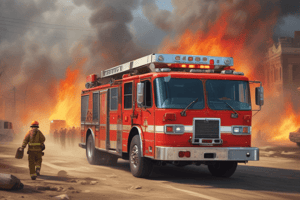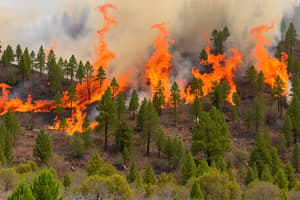Podcast
Questions and Answers
What should be the first action of the first suppression unit in a hydrant area when there is a potential fire?
What should be the first action of the first suppression unit in a hydrant area when there is a potential fire?
- Establish a water supply
- Wait for further instructions
- Set up the command post
- Deploy and charge the appropriate size hose line (correct)
What must the first suppression unit prioritize when positioning near a building?
What must the first suppression unit prioritize when positioning near a building?
- Keep the front of the building open for the truck company (correct)
- Block all road access for other units
- Position in front of the building
- Set up the truck for ventilation
What type of backup line should be deployed during offensive operations?
What type of backup line should be deployed during offensive operations?
- A supply line
- A smaller hose line
- A second equal to or larger size hose line (correct)
- A specialized foam line
In a hydrant area, what is the main responsibility of the second suppression unit?
In a hydrant area, what is the main responsibility of the second suppression unit?
What should the first arriving truck company primarily focus on?
What should the first arriving truck company primarily focus on?
What is an additional task the first suppression unit may perform in non-hydrant areas?
What is an additional task the first suppression unit may perform in non-hydrant areas?
How does the second suppression unit secure a water supply in non-hydrant areas?
How does the second suppression unit secure a water supply in non-hydrant areas?
What is the primary focus of the second suppression unit officer in non-hydrant areas?
What is the primary focus of the second suppression unit officer in non-hydrant areas?
Who is authorized to relieve the water supply officer (WSO) of their duties?
Who is authorized to relieve the water supply officer (WSO) of their duties?
What key area must be kept open by the first suppression unit for the truck company in non-hydrant areas?
What key area must be kept open by the first suppression unit for the truck company in non-hydrant areas?
What is the primary function of the second hose line in offensive operations?
What is the primary function of the second hose line in offensive operations?
In hydrant areas, what should the second suppression unit do if the water supply has not been established?
In hydrant areas, what should the second suppression unit do if the water supply has not been established?
What tactical action may the first suppression unit take in a non-hydrant area to ensure water supply?
What tactical action may the first suppression unit take in a non-hydrant area to ensure water supply?
What should the truck company prioritize unless otherwise directed?
What should the truck company prioritize unless otherwise directed?
What water supply method is primarily utilized by the second suppression unit in non-hydrant areas?
What water supply method is primarily utilized by the second suppression unit in non-hydrant areas?
When should the second suppression unit officer assume the role of water supply officer (WSO)?
When should the second suppression unit officer assume the role of water supply officer (WSO)?
Which unit is tasked with deploying the first charged hose line when an active fire is suspected?
Which unit is tasked with deploying the first charged hose line when an active fire is suspected?
What should the second suppression unit do if the first suppression unit has already set up a water supply in a hydrant area?
What should the second suppression unit do if the first suppression unit has already set up a water supply in a hydrant area?
Flashcards are hidden until you start studying
Study Notes
Tactical Assignments for First Alarm Responses
-
Initial Actions in Hydrant Areas: The first suppression unit must deploy and charge the appropriate size hose line when an active fire is suspected.
-
Positioning Near Buildings: Maintaining access for the truck company is crucial; the first suppression unit should keep the front of the building accessible.
-
Backup Line Requirements: During offensive operations, a second hose line equal to or larger in size should be deployed as a backup.
-
Role of the Second Suppression Unit in Hydrant Areas: Its primary responsibility is to establish a water supply for the first suppression unit.
-
Truck Company Responsibilities: On arrival, the first arriving truck company should set up for ventilation, enabling efficient fire operations.
-
Non-Hydrant Areas Operations: The first suppression unit may need to deploy a supply line into the incident as an additional operational task.
-
Water Supply Establishment in Non-Hydrant Areas: The second suppression unit uses relay pumping or tanker operations to establish a water supply.
-
Water Supply Officer (WSO) Role: The second suppression unit officer becomes the WSO in non-hydrant areas, focusing on water supply management.
-
WSO Relief Protocol: The ranking officer may relieve the WSO of their duties, ensuring command consistency.
-
Access Areas to Keep Open: In non-hydrant areas, it is essential for the first suppression unit to keep the front of the building open for truck company access.
-
Second Hose Line Capabilities: The second hose line acts as a backup line during firefighting operations, enhancing the effectiveness of offensive maneuvers.
-
Water Supply Protocol in Hydrant Areas: If the first unit has not secured a water supply, the second suppression unit must take immediate action to establish it.
-
Tactical Actions for Water Supply in Non-Hydrant Areas: The first suppression unit should deploy a supply line into the incident to secure water access.
-
Ventilation Setup: The truck company should prioritize setting up for ventilation unless instructed otherwise, optimizing fire response efforts.
-
Dominant Water Supply Method in Non-Hydrant Areas: Relay pumping or tanker operations represent the primary water supply methods for the second suppression unit.
-
Timing for WSO Role Assumption: The second suppression unit officer assumes WSO responsibilities when establishing a water supply in non-hydrant scenarios.
-
First Charged Hose Line Deployment: The first suppression unit is accountable for deploying the initial charged hose line in the event of an active fire.
-
Post-Water Supply Establishment Actions: If the first suppression unit has established a water supply in hydrant areas, the second suppression unit should assist with firefighting operations.
-
Main Tactical Consideration for Truck Companies: Upon arrival, truck companies should focus on setting up ventilation as a key tactical priority.
-
Water Supply Usage in Non-Hydrant Areas: The second suppression unit predominantly employs relay pumping or tanker operations in the absence of hydrant access.
Studying That Suits You
Use AI to generate personalized quizzes and flashcards to suit your learning preferences.




